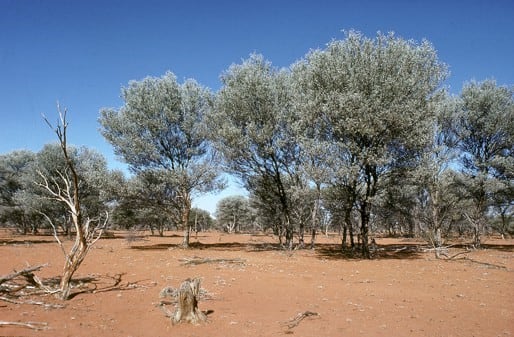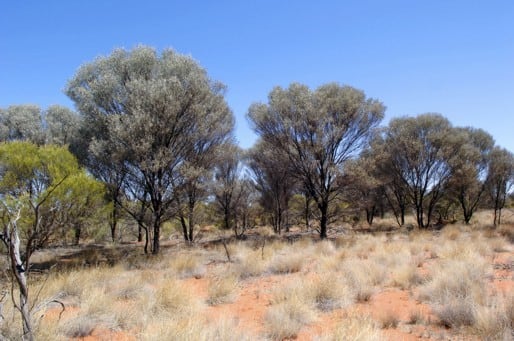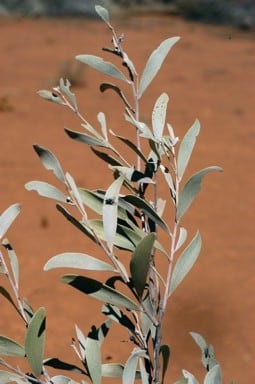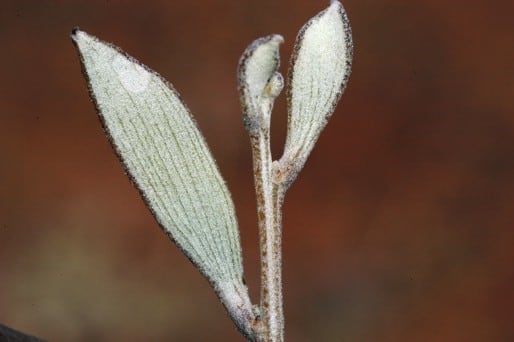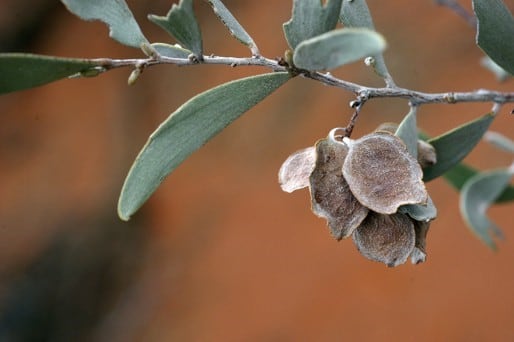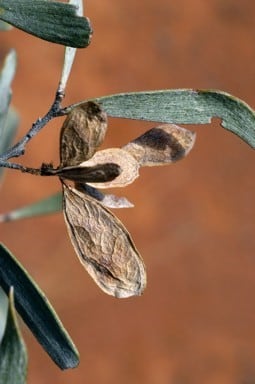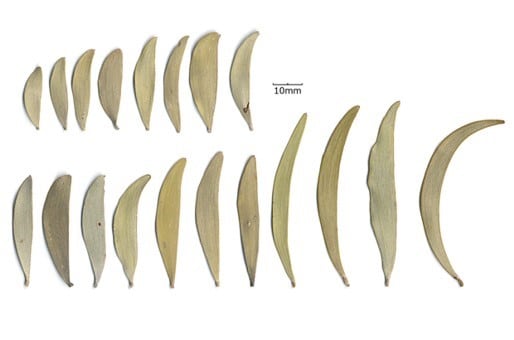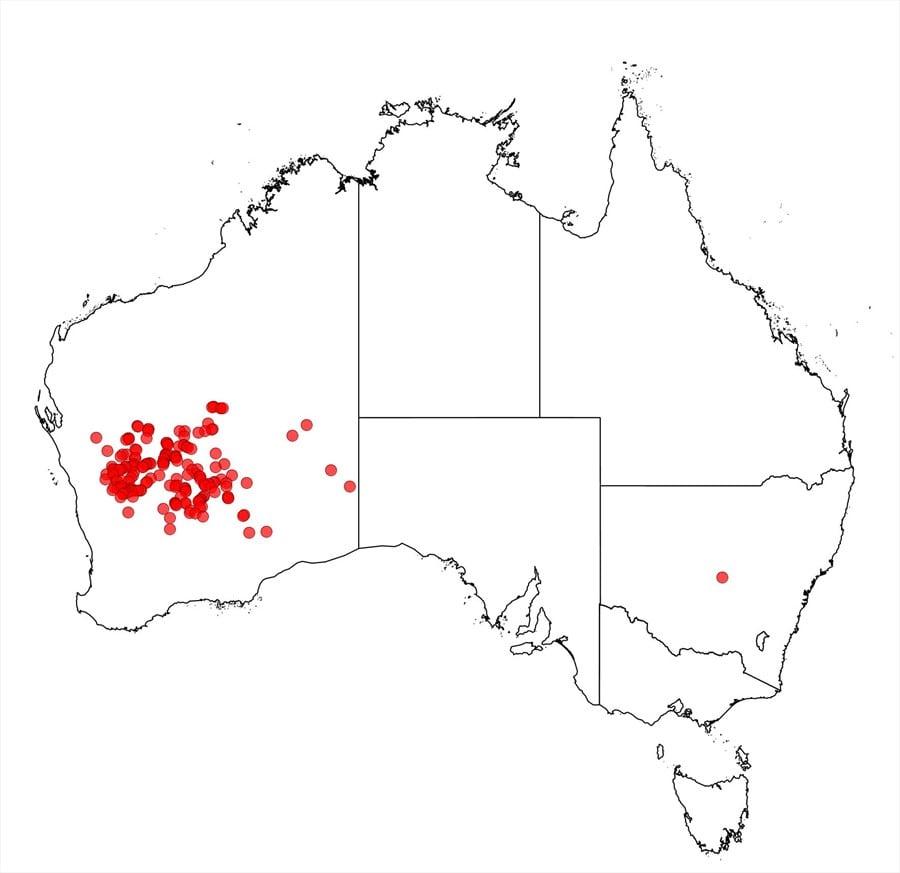Acacia caesaneura Maslin & J.E.Reid
WATTLE
Acacias of Australia
Common Name
Western Blue Mulga
Family
Fabaceae
Distribution
Endemic in W.A. with most collections from an area bounded approximately by Yalgoo, Meekatharra, Lorna Glen Stn (c. 150 km ENE of Wiluna), Laverton and Kalgoorlie; the most easterly record is Kanandah Stn (c. 330 km E of Kalgoorlie) on the northern edge of the Nullarbor Plain.
Description
Multi-stemmed shrub maturing to shapely, obconic tree 3–8 (–10) m high, crowns dense and silvery bluish grey, grey or grey-green tinged blue. Branchlets densely appressed-pubescent between rather obscure resinous ribs towards apices, the resin normally not well-developed; new shoots not or scarcely resinous, the youngest phyllodes densely tomentulose (hairs usually white) except for dark-coloured, resinous marginal nerve, sometimes (in narrow-phyllode variant) indumentum less prominent with hairs confined to between longitudinal nerves. Phyllodes variable, straight and dimidiate to falcately recurved, commonly narrowly oblong to elliptic, not rigid, (2–) 3–7 (–8) cm long, (2–) 2.5–10 (–12) mm wide, longitudinal nerves numerous and often appressed-hairy between, broadest phyllodes sometimes felty, marginal nerve resinous but often not especially prominent, the resin normally milky white or yellow (sometimes light brown on oldest phyllodes). Inflorescences simple; peduncles 2–10 mm long, often densely appressed-hairy; spikes 10–20 mm long. Flowers 5-merous; sepals ½ or slightly more than ½ length of petals. Pods oblong, 1.5–3.5 (–4.5) cm long, (7–) 10–15 (–20) mm wide including wings 1–2 (–2.5) mm, firmly chartaceous, flat, greyish brown, obscurely reticulate. Seeds oblique to transverse, 4–6 (–7) mm long, 2–3 (–3.5) mm wide, oblong to ±elliptic; aril small and whitish.
Habitat
Commonly grows on plains or in gently undulating country in red-brown sandy loam to clay, often over hardpan at a relatively shallow depth, in mixed Acacia shrubland or woodland communities dominated by Mulga species (especially A. incurvaneura).
Specimens
W.A.: 8 km ENE of Yuinmery HS, J.Dell JD46 (PERTH); 10 miles [16 km] E of Paynesville, J.W.Green 1626 (PERTH); western boundary of Kanandah Stn, G.J.Keighery & J.J.Alford 562 (PERTH); 66 km W of Sandstone on road to Mt Magnet, B.R.Maslin & J.E.Reid BRM 9753 (CANB, K, MEL); c. 55 km S of Laverton, around dining area Anglogolds Sunrise Dam Mine camp, B.R.Maslin & J.E.Reid BRM 9699 (CANB, K, MEL, PERTH: narrow-phyllode variant).
Notes
Acacia caesaneura is a member of the ‘A. aneura group’ (Mulga) recognized by a combination of its usually non-resinous, tomentulose new shoots, reduced branchlet resin and relatively large, straight and dimidiate or falcately recurved (never incurved) phyllodes. It is closely related to A. incurvaneura which normally has narrower, incurved phyllodes; these two species are commonly sympatric and putative hybrids/intergrades are common. Also related to A. mulganeura which has very resinous new shoots, straight (never recurved), symmetrical (never dimidiate) phyllodes that are often shorter, smaller sepals and bracteoles, generally narrower pods and is commonly of lower stature; possible hybrids/intergrades between these two species are noted under A. mulganeura. The narrow-phyllode variants of A. caesaneura and A. ayersiana can sometimes be difficult to separate; the most reliable way to distinguish them is the shorter sepals relative to the petals in the latter species, see B.R.Maslin and J.E.Reid, Nuytsia 22(4): 190–198 (2012), for further discussion.
A very variable species in need of further study. Juvenile phyllodes are rather short, straight and dimidiate; mature phyllodes are longer and falcately recurved; individual plants may have one or other of these shapes, or a mixture of the two, depending upon their age; some adult plants (5 m or more high) have only the juvenile phyllode form. Acacia caesaneura varies considerably in phyllode width, with two main variants recognized: the typical variant has phyllodes 6–10 (–15) mm wide but a narrow-phyllode variant (2–6 mm wide) is scattered throughout the geographic range and is commonly sympatric with the typical variant; see B.R.Maslin & J.E.Reid, loc. cit., for discussion. Resin on branchlet ribs is normally poorly developed (sometimes absent); it is typically opaque but is occasionally interspersed with patches of translucent resin. Colour of new shoot indumentum is normally white but in eastern part of the range it is occasionally very pale yellow, e.g. P.G.Wilson 7497 (c. 65 km NNE of Leonora).
This taxon was treated as A. aneura var. argentea by L.Pedley, Fl. Australia 11B: 322 (2001), but B.R.Maslin & J.E.Reid, loc. cit., consider it warrants recognition as a distinct species. The specimen A.A. Burbidge 4 cited by L.Pedley, loc. cit., cited under A. aneura var. argentea is A. mulganeura.
It is sometimes difficult to distinguish A. caesaneura from A. ayersiana: see A. ayersiana for discussion.
FOA Reference
Data derived from Flora of Australia Volumes 11A (2001), 11B (2001) and 12 (1998), products of ABRS, ©Commonwealth of Australia
Author
L.Pedley
This identification key and fact sheets are available as a mobile application:
URL: https://apps.lucidcentral.org/wattle/
© Copyright 2018. All rights reserved.

